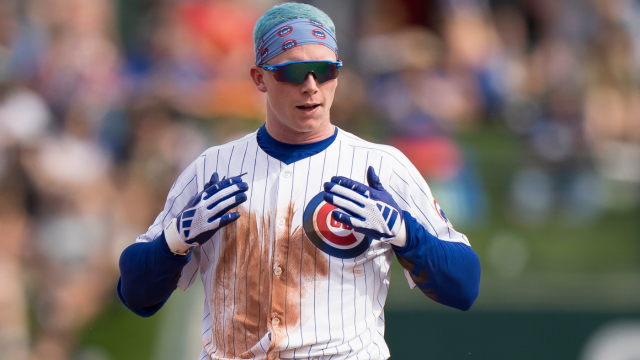Unexpected Trade: Pete Crow-Armstrong Moves to the Detroit Tigers in Blockbuster Deal with Chicago Cubs
In a stunning move that has left the baseball world buzzing, the Detroit Tigers have acquired highly regarded outfield prospect Pete Crow-Armstrong from the Chicago Cubs in a trade deal that has sent shockwaves through the league. The trade, which was finalized late last night, sees Crow-Armstrong, a top-tier prospect, head to Detroit in exchange for a massive package of players and prospects. This unexpected deal has many wondering how it will impact both teams, especially in terms of their future rosters and playoff aspirations.
Pete Crow-Armstrong: A Rising Star
Pete Crow-Armstrong, 21, has been one of the most talked-about prospects in the Cubs’ system since being drafted in the first round of the 2020 MLB Draft. Known for his outstanding defensive abilities and impressive bat-to-ball skills, Crow-Armstrong quickly established himself as one of the most promising young outfielders in the game. His quick reflexes, strong arm, and excellent instincts in the field have drawn comparisons to some of the game’s elite center fielders. Offensively, he has shown steady progress, with a solid batting average and increasing power numbers as he moved up the minor league ranks.
Crow-Armstrong’s stellar performance in the minor leagues earned him a reputation as a potential cornerstone piece for the Cubs’ future. His ability to contribute both offensively and defensively made him a highly coveted prospect, with many believing he was destined to be a fixture in the Cubs’ outfield for years to come. However, the Cubs’ decision to part with such a prized asset caught many by surprise, signaling a shift in their overall strategy.
The Trade Details
While the specifics of the deal are still coming into focus, reports indicate that the Cubs received a significant return for Crow-Armstrong. The trade package reportedly includes several talented prospects and a veteran player, all of whom could provide the Cubs with immediate help and long-term value. Among the names mentioned in the trade are top pitching prospect Jackson Jobe, who has been impressing scouts with his electric fastball and impressive command, and veteran outfielder Riley Greene, who could offer the Cubs an experienced bat while they continue their rebuild.
The inclusion of Jobe, a 21-year-old right-hander, is especially intriguing. He has the potential to become a future ace in the Cubs’ rotation, making him a valuable asset in the long run. Greene, on the other hand, adds a solid bat to the Cubs’ lineup while bringing some much-needed experience to their young roster. The addition of these players is expected to help the Cubs in both the short and long term as they continue to rebuild and develop their team.
For the Tigers, the addition of Crow-Armstrong represents a significant step forward in their own rebuilding efforts. The team has been stockpiling young talent over the past few seasons, and the addition of a player of Crow-Armstrong’s caliber only strengthens their future outlook. With a solid mix of experienced players and emerging stars, the Tigers are hoping that Crow-Armstrong will be the missing piece they need to take the next step in their quest for a playoff berth.
The Cubs’ Strategy
The decision to trade Pete Crow-Armstrong raises questions about the Cubs’ long-term strategy. While some fans may be disappointed to see such a promising talent leave the organization, the Cubs’ front office may have seen an opportunity to expedite their rebuild by acquiring multiple assets that could contribute sooner rather than later. The Cubs have been in a rebuilding phase for the past few seasons, and this trade suggests they are focused on accelerating their timeline to return to contention.
The inclusion of Riley Greene and Jackson Jobe could also signal a shift toward balancing youth with experience, allowing the Cubs to build a team that can compete in the near future while also keeping an eye on sustainable success over the long term. This trade could be just one of several moves the Cubs make as they continue to reshape their roster.
Impact on the Tigers
For the Detroit Tigers, acquiring Crow-Armstrong is a significant move that underscores their commitment to building a competitive team. The Tigers have been focused on developing their young talent in recent seasons, and Crow-Armstrong’s addition could be the catalyst that propels them to the next level. His ability to play center field at an elite level and contribute at the plate gives the Tigers an exciting piece to build around.
With a strong core of young players like Spencer Torkelson, Riley Greene, and now Crow-Armstrong, the Tigers are positioning themselves to be a serious contender in the American League in the coming years. While the team may still be a few years away from making a deep playoff run, the trade for Crow-Armstrong signals that the Tigers are not content to wait indefinitely—they are ready to compete.
Conclusion
The trade that sent Pete Crow-Armstrong to the Detroit Tigers in exchange for a substantial package of players and prospects is one of the most unexpected moves of the offseason. While it raises questions about the direction of both teams, it also highlights the evolving landscape of Major League Baseball. For the Cubs, it represents a calculated step in their rebuilding process, while for the Tigers, it’s an exciting move that strengthens their future aspirations.
As both teams look to build for the future, the ramifications of this trade will be felt for years to come. Crow-Armstrong’s potential as a star player in Detroit could be the spark the Tigers need to return to prominence, while the Cubs’ haul of talent could set them up for sustained success as they look to rebuild their franchise from the ground up.
